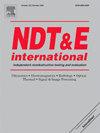Analysis of the detective quantum efficiency of a dual-energy photon-counting X-ray detector
IF 4.1
2区 材料科学
Q1 MATERIALS SCIENCE, CHARACTERIZATION & TESTING
引用次数: 0
Abstract
Photon-counting detectors (PCDs) are an emerging technology that provide energy-selective images for a single X-ray exposure. For studies considering PCDs for industrial non-destructive inspection, presenting a metric describing the imaging efficiency or performance of PCDs is important. In this study, we describe the imaging performance in terms of the detective quantum efficiency (DQE) and report the results of the DQE analysis for a sample PCD using a representative X-ray spectrum (70 kV and 21-mm Al filtration). The PCD, a mosaic of eight small detector modules, employs two adjustable energy thresholds and possesses a function called an anti-coincidence (AC) operation, which sums charges spread over four pixels into a pixel exhibiting the highest charge signal. The DQE measurements confirmed that, without correction for the signal and noise correlation between the energy bins, the DQE could be incorrectly overestimated. The AC or charge-summing operation effectively suppressed the signal and noise correlations between the energy bins, enhanced the modulation-transfer functions and removed the cross-noise-power spectra (cross-NPSs) but increased the normalized NPSs in each energy-bin image, degrading the resulting DQE performance. The performance gap between the measured DQE and theoretical models is discussed. The DQE forms and analysis methodologies presented in this paper will be helpful for researchers seeking to understand PCD-based imaging systems.
双能光子计数x射线探测器探测量子效率分析
光子计数探测器(PCDs)是一种新兴的技术,可以为单个x射线曝光提供能量选择图像。对于考虑PCDs用于工业无损检测的研究,提出描述PCDs成像效率或性能的度量是重要的。在本研究中,我们从探测量子效率(DQE)的角度描述了成像性能,并报告了使用代表性x射线光谱(70 kV和21 mm Al过滤)对样品PCD进行DQE分析的结果。PCD是由8个小探测器模块拼接而成,采用两个可调的能量阈值,并具有一种称为反重合(AC)操作的功能,该功能将分布在4个像素上的电荷求和为显示最高电荷信号的像素。DQE测量证实,如果不校正能量桶之间的信号和噪声相关性,DQE可能会被错误地高估。交流或电荷相加操作有效地抑制了能量桶之间的信号和噪声相关性,增强了调制传递函数,消除了交叉噪声功率谱(cross- nps),但增加了每个能量桶图像的归一化nps,降低了DQE的性能。讨论了实测DQE与理论模型之间的性能差距。本文提出的DQE形式和分析方法将有助于研究人员了解基于pcd的成像系统。
本文章由计算机程序翻译,如有差异,请以英文原文为准。
求助全文
约1分钟内获得全文
求助全文
来源期刊

Ndt & E International
工程技术-材料科学:表征与测试
CiteScore
7.20
自引率
9.50%
发文量
121
审稿时长
55 days
期刊介绍:
NDT&E international publishes peer-reviewed results of original research and development in all categories of the fields of nondestructive testing and evaluation including ultrasonics, electromagnetics, radiography, optical and thermal methods. In addition to traditional NDE topics, the emerging technology area of inspection of civil structures and materials is also emphasized. The journal publishes original papers on research and development of new inspection techniques and methods, as well as on novel and innovative applications of established methods. Papers on NDE sensors and their applications both for inspection and process control, as well as papers describing novel NDE systems for structural health monitoring and their performance in industrial settings are also considered. Other regular features include international news, new equipment and a calendar of forthcoming worldwide meetings. This journal is listed in Current Contents.
 求助内容:
求助内容: 应助结果提醒方式:
应助结果提醒方式:


